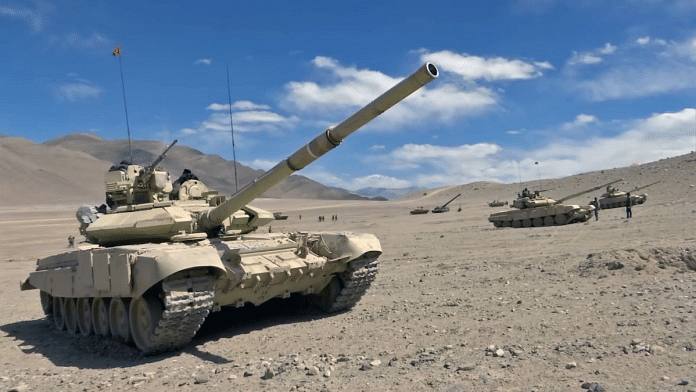New Delhi: The Indian Army is scouting for protection gear to boost the survivability of its T-90 tanks, with the Ukraine war exposing the vulnerability of Russian armoured units to new-age weapons.
This pursuit involves equipping the Russian origin T-90, a workhorse for the Army, with an active protection system (APS) that can stave off threats from loitering munitions and top-attack missiles—weapons that have reduced Russian tanks to fireballs.
The Army plans to undertake the upgrades through the Make in India route. Currently, it operates about 1,250 T-90s, with around 350 more on order. A Request for Information (RFI) has been issued to identify the prospective global vendors to manufacture the APS for the T-90 S/Sk tanks in India.
The Russian tanks, the mainstay of the Indian Army, have effective firepower and mobility but with lesser protection compared to the Western Main Battle Tanks (MBTs).
Lightweight, shoulder-fired American-manufactured Javelins, and the Swedish- and British-made New Generation Light Anti-Tank Weapon (NLAW), together with drones, have relentlessly hunted down the Russian tanks in Ukraine.
Over 1,400 Russian tanks are confirmed by independent photographic evidence to have been destroyed, abandoned, or captured—and that’s not counting the armoured personnel carriers, infantry combat vehicles, and tracked artillery, within the first few months itself of the war.
Even though the Russian tanks, designed and produced in the 1970s and the 1980s, have been modernised with explosive reactive armour to mitigate threats from shoulder-fired missiles, they remain vulnerable to systems with tandem warheads, like the Javelins and NLAWs.
They are especially vulnerable to missiles which target the turrets from above, because of design flaws in the ways in which their ammunition-loading systems are configured.
The Western tanks, like the US Abrams MBT, are already being equipped with active protection systems to counter incoming missiles and fight off drones. Israel’s latest tank, the Merkava 5, includes protection systems capable of fighting off the country’s own state-of-the-art Spike anti-tank missile.
While during the Ukraine conflict, some ‘Shtora’ active protection systems were seen on the Russian tanks, the more advanced ‘Arena’ and the latest ‘Afghanit’ systems mounted on the latest T-14 Armata tank were not fielded. These latest systems are also designed to cater for the top-attack threat posed by missiles like Javelin.
The Indian Army admitted that the anti-tank threat is not limited to frontal arc but has
become omnidirectional. The tank design based on the equilateral triangle of lethality, mobility and survivability allows limited measures to enhance survivability by increasing armour protection.
Therefore, in order to counter the current generation of anti-tank threats including from Unmanned Aerial Systems (UAS), the Active Protection System is an efficient and cost-effective system to enhance survivability of tanks in the modern battlefield and the same has been reflected in various present conflicts around the globe, the Army said in its RFI.
The APS being offered should have Soft Kill, Hard Kill and Counter Unmanned Aerial System (C-UAS) measures and should be capable of being integrated with T-90 without denuding existing capabilities of the tank.
The APS should be able to detect all types of UAS including loitering UAVs, first person view (FPV), swarm, and Kamikaze drones. It should also be capable of detecting all types of anti tank projectiles in terms of RPG, ATGM, chemical and kinetic energy munitions, reads the Army document.
The Army has made it clear that the APS should not in any way compromise the mobility of the tanks and should be able to operate in high altitude areas, too. Incidentally, the Defence Research and Development Organisation (DRDO) had last year initiated work on an indigenous APS for the Indian tanks.
This is an updated version of the report
(Edited by Tony Rai)
Also Read: Boost for India as DRDO successfully conducts scramjet engine ground test for hypersonic missiles






